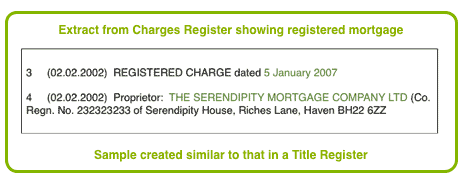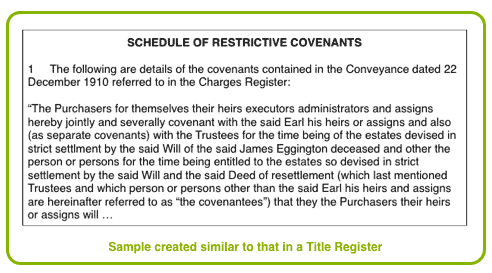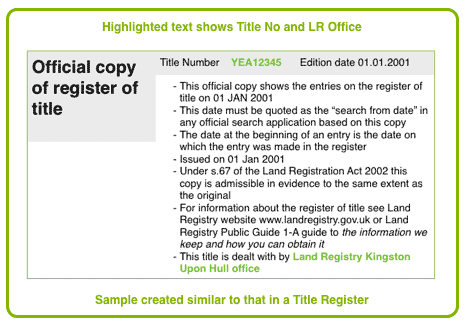Section A
Rule 5 demonstrates the importance of using the title register and title plan together in looking at the description of a property. Where a property has a full property address the exercise is fairly straight forward, but where the property consists of a field or similar the importance of describing the property by reference to a plan is of major significance.
Summary of Contents of A Section of the Register
- Description of the land with reference to the Title Plan.
- Details of any exclusions from the title, such as mines and minerals particulars of Lease (if leasehold).
- Agreements and declarations
- Statement that the landlord's Title is registered (if leasehold).
- Matters that benefit the land such as:
- Easements
- Rights
- Privileges
- Conditions
- Covenants
- Party wall declarations
Mines and minerals are often excluded from the title as these may either be owned by the Crown or have been sold off with a separate title.
Section A is the part of the register that details matters that benefit the land, such as easements which are private rights to use another's property without owning it, and such as a right of way over adjoining land, a right of light, right of access or right of support. A right of way recorded in section A is one in favour of the owner of the title. If it were referred to in section C instead, then it would be a right that would encumber the land, i.e. it would be in favour of your neighbour and provide rights over your property.
Likewise, the rights, privileges, conditions and covenants recorded in section A are all matters that benefit the land.
Where the property is of a leasehold tenure section A will also contain sufficient particulars of the lease to enable it to be identified (Rule 6). Copies of the lease can be obtained by the leaseholder or freeholder of the property using the Lease Search.
Section B
Rule 8 of the Land Registration Rules defines the contents of the B section of the register, known as the proprietorship register.
There are 4 classes of title:
- Absolute Freehold or Absolute Leasehold
- Good Leasehold
- Possessory Freehold or Possessory Leasehold
- Qualified Freehold or Qualified Leasehold
Summary of Contents of B Section of the Register
- Class of Title
- Name of the owner
- Address for service of the owner
- Restrictions
- Notices
- Positive covenants
- Purchase price (or value declared)
A property with an absolute title is one that can be described as safe to purchase, as the purchaser should obtain an unfettered title.
Good leasehold title is given where the title from which it derives (the freehold title or superior leasehold title) has not itself been examined by the Land Registry (as where the freehold title is itself unregistered); thus the Land Registry are unable to guarantee that the lease creating the good leasehold title was validly granted.
Possessory title is given where the owner of a property with unregistered title has lost the deeds, or where they have been destroyed, e.g. by fire. This class of title is also given following a successful claim for adverse possession, i.e. where someone has used the property as their own for a continuous period of at least 10 years and where their use thereof has not been interrupted.
Qualified title is the least desirable title to have and is given where the title to the property is defective, e.g. on first registration the purchaser may not have been able to show a good root of title.
Name of owner
Registration of the owner's name under Rule 8 applies whether the owner is an individual or company. In the case of a company the company's registered number would also be recorded.
Address of Owner
The address of the owner is the address where that owner can be served with documents. Not all property owners reside in their property; many are landlords and reside elsewhere. In an attempt to combat property fraud HM Land Registry now allow up to 3 different addresses for service for each owner of the property. This can include an email address and an address Abroad. Upon an application to change the register the Land Registry will contact the owner at all addresses for service registered with them. They produce an information guide that is available free from their website and provides more detail on how to protect your property from fraud.
Restrictions
Restrictions on an owner's power to sell will also appear in this part of the register. An example of such a restriction would be where there are joint owners who hold the property as tenants in common. A restriction would be recorded to show that a disposition of the property cannot be registered without the consent of each owner, unless authorised by the court. The wording would appear as follows:
RESTRICTION: No disposition by a sole proprietor of the registered estate (except a trust corporation) under which capital money arises is to be registered unless authorised by an order of the Registrar or the court.
Notices
An example of a Notice is where a creditor has obtained a judgment against an owner of the property and then obtained a charging order to secure a debt. This would be registered as a Unilateral Notice in accordance with section 32 Land Registration Act 2002. Another example is a Bankruptcy Notice, which would be applied for by the trustee in bankruptcy.
The purpose of registration of Restrictions and Notices is to put third parties on notice that the right of an owner to make a disposition may be fettered.
Positive Covenants
Positive Covenants do not run with the land but affect only the current owner. It is for this reason that they are distinguished in their placement within the register from restrictive covenants that appear in the C section. A vendor's conveyancer would normally require a new purchaser to enter into a similar positive covenant to ensure that the covenant continues, and to indemnify the vendor against any future breach or non-observance thereof.
Purchase Price
From the year 2000 the purchase price of the property is also recorded. If the consideration for the purchase was something other than money, e.g. the natural love and affection of the vendor for the purchaser, instead of the purchase price the purchaser would instead estimate its value and that would be recorded. Prior to the year 2000 the purchase price was not recorded. Sometimes the purchase price is omitted, e.g. where many properties were purchased and have been recorded on the same title, and where it would be difficult to determine the purchase price or value of each separately.
The purchase price will also not be recorded where the owner makes a successful application to the Land Registry to omit it. He will need to show a good reason to succeed in this.
Section C
Section C deals with matters that incumber the property. Rule 9 of the Land Registration Rules determine the content of the C section of the Register, also known as the Charges Register. The following appear under this section, where they exist:
- leases
- charges
- other interests adversely affecting the property
- restrictions relating to charges
- notices relating to charges
Where a lease has been granted in respect of the property details of that lease will appear in this section.

Freeholds and Leaseholds
Where a property has both a freehold title and a leasehold title, people looking for certain information may be undecided as to whether to obtain a copy of the leasehold title or whether to obtain a copy of the freehold title.
This is of particular relevance where a person wishes to know who to contact for details of a ground or chief rent, or for details of a lease.
As will be seen from the above, freehold titles will include details of any registered leasehold titles in the C section of the register. The freehold title, of course, will show the name and address of the owner of the freehold title, and it will be that owner to whom payment of the ground rent should be paid.
The individual leasehold title registers will contain details of that title's lease only. This will appear in the A section and will contain the date of the lease, its length (term), the amount of ground rent payable, and the parties to the lease. If the landlord's title is also registered there will usually be a statement to this effect.
References to Deeds
The Land Registry do not always iterate on the Register all of the detail contained in deeds that affect the property. Sometimes only brief details of the salient points will be provided, and beneath the paragraph containing those details will appear wording similar to "copy filed" or "copied into the certificate".
Where this is the case the Land Registry are obliged to keep copies of the deeds and these are usually held on their computers. These deeds are available for purchase where one wishes to view their entire content. Using the Deeds Search you can obtain copies of all the deeds referred to in this manner.
Schedules

The property, proprietorship and charges registers may contain one or more schedules before the commencement of the next section, e.g. the proprietorship register may contain a schedule of personal covenants. It is often more convenient to list matters such as these in a schedule at the end of the section. The charges register may contain a schedule of restrictive covenants, a schedule of leases and/or a schedule of exceptions and reservations.
Other Data in the Register

Prior to the 3 main sections of the title register a note is made by the Land Registry of some important information. This includes the registered title number, and the name of the Land Registry office dealing with that property (which in this sample we have highlighted in green).